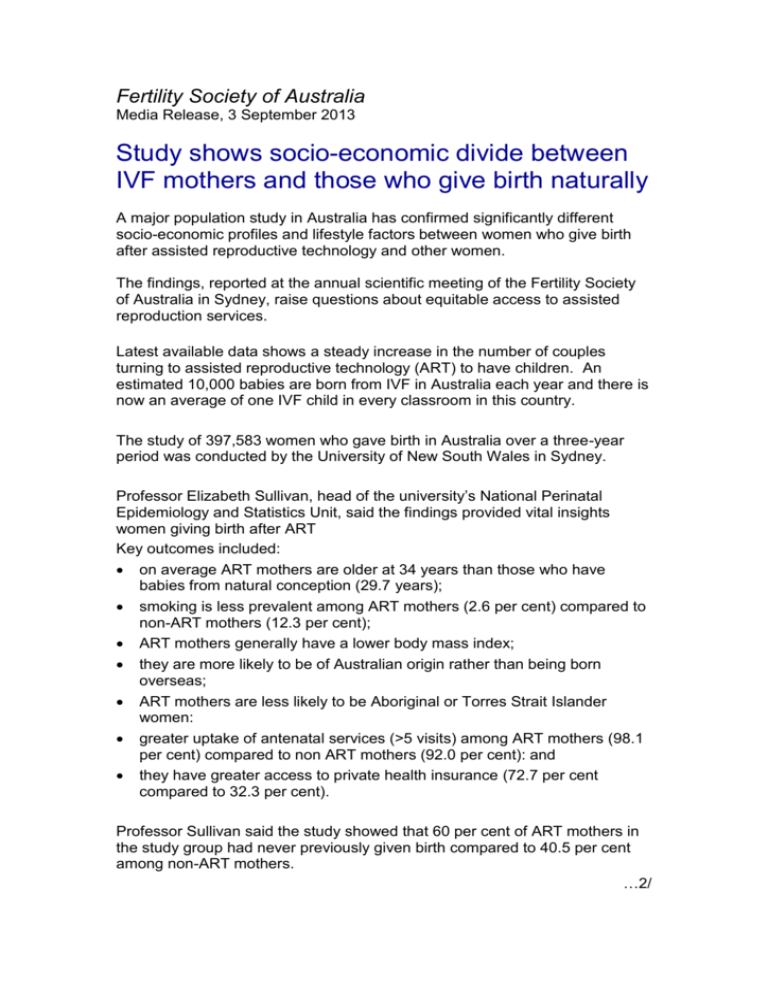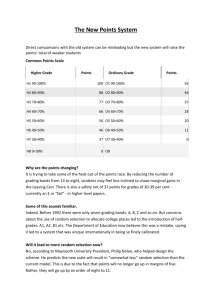A major population study has confirmed significantly different socio
advertisement

Fertility Society of Australia Media Release, 3 September 2013 Study shows socio-economic divide between IVF mothers and those who give birth naturally A major population study in Australia has confirmed significantly different socio-economic profiles and lifestyle factors between women who give birth after assisted reproductive technology and other women. The findings, reported at the annual scientific meeting of the Fertility Society of Australia in Sydney, raise questions about equitable access to assisted reproduction services. Latest available data shows a steady increase in the number of couples turning to assisted reproductive technology (ART) to have children. An estimated 10,000 babies are born from IVF in Australia each year and there is now an average of one IVF child in every classroom in this country. The study of 397,583 women who gave birth in Australia over a three-year period was conducted by the University of New South Wales in Sydney. Professor Elizabeth Sullivan, head of the university’s National Perinatal Epidemiology and Statistics Unit, said the findings provided vital insights women giving birth after ART Key outcomes included: on average ART mothers are older at 34 years than those who have babies from natural conception (29.7 years); smoking is less prevalent among ART mothers (2.6 per cent) compared to non-ART mothers (12.3 per cent); ART mothers generally have a lower body mass index; they are more likely to be of Australian origin rather than being born overseas; ART mothers are less likely to be Aboriginal or Torres Strait Islander women: greater uptake of antenatal services (>5 visits) among ART mothers (98.1 per cent) compared to non ART mothers (92.0 per cent): and they have greater access to private health insurance (72.7 per cent compared to 32.3 per cent). Professor Sullivan said the study showed that 60 per cent of ART mothers in the study group had never previously given birth compared to 40.5 per cent among non-ART mothers. …2/ -2They were also more socially privileged (27.8 per cent compared to 17.7 per cent in non-ART mothers) based on the Australian Bureau of Statistics index of social disadvantage. “During the study period, more than 42.2 per cent of fertility clinics were concentrated in the most socially privileged areas with 71.1 per cent of the clinics in major cities compared with 26.7 per cent in regional centres and 2.2 per cent in remote areas,” Professor Sullivan said. “This data is part of a larger study comparing general health and other issues among ART and non-ART mothers in Australia with an on-going focus on complications in pregnancy and birth outcomes. “Further research is needed to determine how access to care and utilisation of services contributes to successful ART outcomes. “However, the preliminary findings suggest that the provision of ART services is biased towards the socially advantaged. “Demand for assisted reproduction is expected to increase and it will become a growing priority to ensure equitable access to the technology.” World leaders in assisted reproduction are attending the Fertility Society of Australia meeting to report on latest research findings and treatments to help the one in six couples experiencing infertility. Infertility is defined as the failure to conceive after a year of unprotected intercourse, or the inability to carry pregnancies to a live birth. The cause of infertility are equally shared between men and women, and in some cases the cause is unknown. Nurturing From The Beginning is the theme of the meeting at the Sydney Hilton. Interview: Professor Elizabeth Sullivan is available for interview on (02) 9382 1014 or 0439 994 820 Further Information: Trevor Gill, FSA Media Relations, on 0418 821 948. www.fsaconference.com






